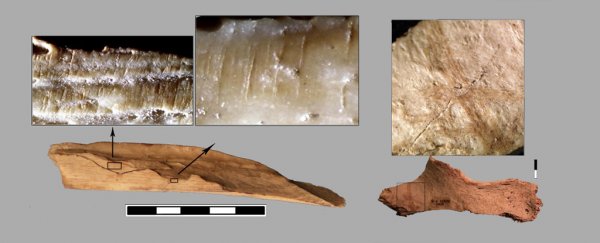Times were tough in Stone Age Europe, so it's not surprising that every now and then we find ancient Homo sapiens bones sporting signs of being gnawed on by other humans.
But a cave about an hour's drive south of Valencia in Spain has provided scientists with what could be the first example of cannibalism among ancient humans living in the western Mediterranean, raising questions on how those who lived in the region roughly 10,000 years ago typically treated their dead.
Researchers studying the dig site of Coves de Santa Maira have studied 30 human bones uncovered over the past few decades that appear to belong to at least two adults and a young child, all of whom lived some time during the final thousand years of the last glacial period.
Many of the adult bones show signs of having been cut and hammered with stone tools, heated, and possibly bitten by other humans, and were found scattered among the remains of other animals, such as ibex and red deer.
Intriguingly, differences in radio-carbon dating suggest this occurred on at least two separate occasions.
While cannibalism is a taboo practice today, it's not at all uncommon in nature, or even in our own past.
But proving what anthropologists call 'anthropophagic practices' within ancient cultures is no simple task.
From an evidence-based perspective, signs of cooking could sometimes be the result of normal funerary practices, or even just the wear and tear of the remains as they slowly move about over the millennia.
"In North African sites … there are dismembered human remains with cut marks associated with secondary burials," the researchers point out in their recent paper.
It's important not to jump to conclusions too quickly, given in some cases bodies were dug up, cut up, and buried in pieces without being served with a side of rabbit.
To be fairly certain that these bones are evidence of cannibalism among our ancient relatives, the researchers applied the following checklist based on the work of French anthropologist Bruno Boulestin:
- Direct proof: the presence of human bones within human coprolites or the identification of human bites on human bones.
- Indirect proof: mainly cooking or pot polish marks.
- First-order primary criteria: anthropogenic fracture and differential anatomical representation
- Second-order primary criteria: mainly cut marks
- Secondary criteria that are not directly related to functional exploitation: position and preservation of the bones and presence of burned bones.
In simpler terms, if you find human bones in human poo, marks on bones associated with cooking, bones that seem to have been pounded open or cut into with a tool, or bones scattered rather than neatly placed, you can confidently conclude 'cannibalism'.
In this case, the researchers were able to tick boxes 2-5, missing out on human bones in coprolite, or preserved faeces.
Distinguishing the marks made by our own teeth from those of an animal isn't always clear, yet in this case the researchers were fairly sure the double arch punctures and triangular pits were a good sign that they came from human canines and molars.
So, the evidence has piled up in favour of at least two meals of human flesh and marrow. But why did they do it?
That part remains something of a mystery; humans have been known to eat one another in times of desperation, but there's also the possibility it was simply a way to either honour the dead or insult an enemy, either from one's own family or from an outside group.
The world was changing around 10,000 years ago, with the beginnings of agriculture springing up among some cultures, and populations migrating far and wide as the last ice age came to a close.
It's possible that the community that lived around the Coves de Santa Maira area might have run into hardship, although the numerous animal bones, sea shells, and broad range of resources in the surrounding environment at the time make that hypothesis a little less likely.
An increase in human remains dating to that period in the western Mediterranean suggest there could have been more encounters between different cultures, either leading to conflicts or competition over resources, or even an exchange of new rituals and cultural practices.
Humans and their closest relatives have been burying their dead for at least the last 50,000 years, if not far longer, so it's not hard to imagine in that time there have been a few examples of funeral ritual we might find a little uncomfortable today.
Who knows what bones are left to be discovered, and what secrets of past cultures they might yet reveal.
This research was published in the Journal of Anthropological Archaeology.
